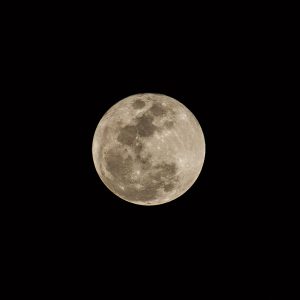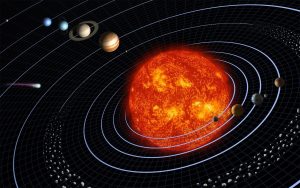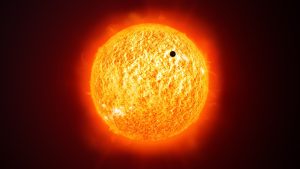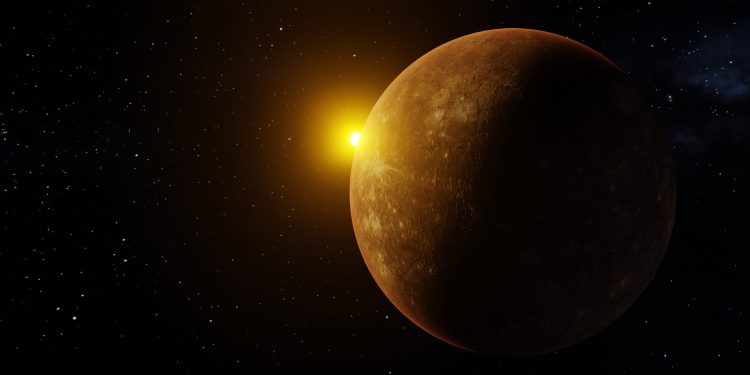People familiarized themselves with the sun and moon way before telescopes were invented. But as science advanced, we found out more about life beyond what the human eyes can see. By now, we know how tiny we are in front of the gigantic universe. Here, we will find out about another remote section as we read through ‘how many moons does Mercury have.’
Moons are natural satellites that revolve around planets. They rotate and revolve in perfect mathematic synchronization as the solar system was created. Dwarf planets, asteroids, and minor planets moons, also fall under the category of natural satellites.
Today, we will discuss Mercury moons and how many moons does Mercury have? To put it in a way, almost every planet in the solar system has its natural satellites.
However, Mercury, the first planet and closest to the sun, does not have any natural satellites. Quite weird, isn’t it?
If having moons is so common and even small asteroids have their natural satellites, then why does Mercury have no moons?
To understand this, we would have to know what a natural satellite is and why it is formed. In this article, we have discussed in detail the answer of how many moons does Mercury have and all the other question that comes along with it.

Table of Contents
What are natural satellites?
Satellites are an object that orbits around a larger object. The satellites are made and launched using rockets into orbit, and each serves some purpose.
Natural satellites are an object that usually orbits around a larger body, usually a planet, naturally. These are not manufactured and are natural.
These natural satellites are also called moons (with a small ‘m’. Earth’s natural satellite is referred to as Moon with a capital ‘m’).
The natural satellites, or moons as we know them, do not have any specific shapes and sizes. Some of these natural satellites also have atmospheres and are generally solid bodies.
Astrologists have discovered around 240 natural satellites present in the solar system. Amongst these four natural satellites orbit around the dwarf planets, 164 natural satellites orbit around the planets, and the remaining orbit around other unknown small bodies in the solar system.
But how many moons does Mercury have? Let us have a look into how many moons or natural satellites does all the planet have:
| Planet | No. of Natural Satellites |
|---|---|
| Mercury | None |
| Venus | None |
| Earth | 1 |
| Mars | 2 |
| Jupiter | 79 (53 of which are confirmed, 26 are provisional) |
| Saturn | 82 (53 of which are confirmed, 29 are provisional) |
| Uranus | 27 |
| Neptune | 14 |
| Pluto (now a dwarf planet) | 3 |
Now we know how many moons the planets have. The fact that the very first planet of the solar system, Mercury, has none might strike a chord.
To understand the answer to how many moons does Mercury have, we would have to know the causes of natural satellites.
How are natural satellites formed?
With years of research and discoveries, astronomers have discovered three important reasons that can lead to the formation of a natural satellite. Let us read through these three reasons.
1. Circumplanetary disk
The first reason that could lead to the formation of a natural satellite is a circumplanetary disk that orbits around a planet. What is a circumplanetary disk, you wonder?
It is a ring or a pancake-shaped disk that is essentially caused due to accumulation of matter. This is composed of planetesimals, gas, dust, and asteroids that revolve around the planets.
What happens here is the circumplanetary disk often comes together to form a whole or a mass resulting in planets having their natural satellites.
Often this mass might not be too large to undergo a hydrostatic equilibrium and hence might not lead to the formation of a natural satellite.
It is believed that Uranus, Neptune, Jupiter, and Saturn have got some of their moons through this process.
2. Collision
The second reason that astronomers believe can lead to the formation of a natural satellite or a moon is when as a result of a massive collision, the planet ejects or leaves some of the material that floats nearby to it in space. These materials then form a mass that eventually results in a natural satellite.
According to the research conducted by the astronomers, our very own planet Earth’s Moon, was formed similarly as such. It is believed that Earth collided with a body (which was almost the size of Mars) referred to as Theia around 4.5 billion years ago. A huge amount of the planet got ejected into space, resulting in Earth’s natural satellite called the Moon.
3. Gravity
The third and last reason that can form a natural satellite or a moon is when a larger body attracts a smaller body through its gravity and force.
According to the astronomers, there are a couple of cases where planets have acquired a natural satellite through this method. For example, Jupiter, Neptune, Saturn, Mars, and Uranus are believed to have got their smaller natural satellites through this process only.
What are the types of natural satellites?
Now that we are aware and know the answer to how many moons Mercury has let us look at the types of natural satellites that are present in the galaxy.
According to various research that astronomers conduct, natural satellites or moons have multiple types and classifications. However, the three main kinds of natural satellites are:
Regular natural satellites or Regular Moons
Regular natural satellites are the ones that have Prograde orbits. This means that these natural satellites orbits in the direction their planets rotate. The moons are of much smaller sizes than their planets that have the same orbit. Along with that, these natural satellites stay close to their planet’s plane of equators.
To take as an example, Earth’s Moon is a natural satellite. The planet Earth rotates from East to West. Likewise, its natural satellite Moon also turns from East to West.
Irregular Natural Satellites or Irregular Moons
Irregular natural satellites or moons are whose orbits are Retrograde or Pro. This means that these satellites can orbit or move backward.
Hence, irregular moons rotate or orbit in the opposite direction to which their planets rotate. Furthermore, these natural satellites remain at a really good distance from their planets’ equators, unlike regular natural satellites.
Astronomers consider this to be a reason that makes them irregular natural satellites. Usually, irregular natural satellites are small planets that the larger planets through their gravitational pull from space.
Inner Natural Satellites or Inner Moons
Inner natural satellites are those who follow a Prograde. Along with that, their orbits are lowly inclined inwards of their planet or the larger satellite.
It is easy to distinguish an inner natural satellite from others. The inner satellites are smaller in size and have irregular shapes.
Their orbital period is short and is usually under a day, and they have low mass. Inner natural satellites have orbits that synchronize with the orbit of their parent planet.
As a result, only one part of them faces the parent planet only. To date, astronomers have discovered around 30 satellites that rotate around four planets in the galaxy. The four planets with inner natural satellites are Saturn, Jupiter, Uranus, and Neptune.
What is the name of the largest natural satellite of the solar system?
Now that we are aware of how many moons does Mercury have, let us have a look at which is the largest natural satellite or natural moon of the galaxy.
The largest natural satellite of the galaxy is called Ganymede. It is approximately 5,262 km in diameter and is of the planet Jupiter.
This natural satellite is way larger when compared with Mercury, the smallest planet in the solar system (after Pluto, which is now termed as a dwarf planet).
Characteristics of Mercury
We know the answer to how many moons does Mercury have, which is, unfortunately, nil. But did you know that some amazing unique characteristics distinguish Mercury from the other planets of the galaxy?

Let us have a look at some of such characteristics of Mercury:
Smallest planet of the solar system
We have known all our lives that Pluto is the smallest of all the nine planets of the solar system, which was true. Since Pluto is now a dwarf planet by the astronomers, the smallest of all eight planets of the galaxy is now Mercury.
You would be amazed to know that the size of Mercury is almost similar to America’s size. The diameter of Mercury is 4,876 kilometers or 3,030 miles. This makes it even smaller than Jupiter’s natural satellite Ganymede (the largest satellite of the galaxy) and Saturn’s natural; satellite Titan.
Scientists believe that there is a constant shrink in Mercury with each passing day. Around 42% of Mercury’s volume consists of a liquid core. As the planet spins, some portion of the liquid core cools down a little causing the planet to shrink more and reduce in size.
It has ice
It is quite weird to imagine that Mercury, the planet closest to the sun, has got ice, right? Scientists believe that Mercury has got ice inside of its craters.
Some recent studies also point to the fact that Mercury’s south and north poles might contain water and ice. This is because even though Mercury is closest to the sun, the north and south poles are shadowy and hence cold.
Although the surface of the planet is extremely hot for being so close to the sun, the floors of its craters are always under shadow hence are probably frozen.
Another possible reason scientists think has brought ice to the crater floors of Mercury is comets and meteorites that might have delivered all the ice that Mercury contains.

It has a crazy orbit
We all know the time that Earth takes to revolve around the sun, right? If you were not aware, it takes 365 days to orbit around the sun, which is a year.
But do you know the period Mercury takes to revolve around the sun? It takes just 88 days!
Mercury’s revolution is faster than all the other planets in the galaxy. It has an elliptical orbit and travels at a speed of 180,000 km/h. During the revolution, it gets closer to the sun, as much as 47 million km away from it, and then travels as further as 70 million km away from the sun.
It has survived a huge asteroid
Scientists believe that about 4 billion years back, a huge asteroid hit Mercury. This collision created a huge depression or a crater spread about 1,545 km or 960 miles across. Along with that, this asteroid had also developed a basin as deep as 60kms.
Mercury has an exosphere
The atmosphere of Mercury is one of the thinnest of all the planets of the solar system. The layer is extremely thin and unlike any other. Thus, scientists gave it the name of exosphere and distinguished it exclusively.
Hence, they termed it as an exosphere. Mostly the bodies that are present in the solar system have an exosphere. Even our planet Earth’s very own natural satellite Moon has an exosphere.

Final thoughts
How many moons does Mercury have is extremely short – it is none. However, even though Mercury has no natural satellite of its own, many unique features of it make it stand out from the rest of the planets of the solar system.


